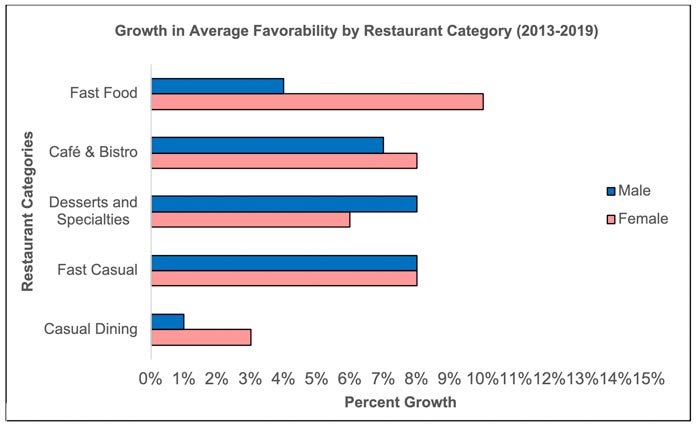
Article contributed by Chris Becker, Rising Consumers
In the interconnected age in which we live, it isn’t hard for any person to be up to date on the latest things going on in the food world. Whether it’s food truck top-25 lists from the Food Network or the multitude of avocado toast recipes from the New York Times, Americans are constantly hearing about the next big food trend.
While popular in the moment, though, many of these seem to end almost as quickly as they begin (Kim Kardashian’s famed appetite-suppressing lollipops, anyone?). Yet there is a more subtle and longer-term trend among younger consumers in particular that should start getting the attention it deserves – female consumers increasingly prefer fast food as much as males do.
This is the case according to research conducted by Rising Consumers, a market research firm focused on young adult consumers. In annual national surveys conducted between 2013 and 2019, respondents were asked to rate the favorability of a number of national and regional restaurant brands, including 11 of the leading fast food chains. Results were surprising.
In 2015, male respondents gave fast food chains an average favorability score of 2.43 (0-4 scale), while female respondents only gave the chains a score of 2.23. This gap narrowed substantially from 0.20 to just .08 in 2019, as favorability scores rose faster among young women:
Year |
|||||||
2013 |
2015 |
2016 |
2017 |
2018 |
2019 |
||
Gender |
Male |
2.43 |
2.43 |
2.42 |
2.50 |
2.53 |
2.53 |
Female |
2.23 |
2.22 |
2.29 |
2.34 |
2.40 |
2.45 |
|
This trend is apparent when analyzing individual restaurants as well. In 2013, nine of the 11 restaurants on the survey had statistically higher favorability among men. In 2019, only four of the 11 did.
This result was also not observed in other restaurant categories. In fact, female favorability of Fast Food outgrew Fast Casual, Casual Dining, Café & Bistro, and Drinks and Specialties over the same period (which averaged about 6% average growth). For males, Fast Food favorability lagged all other categories besides Casual Dining.
 As shown in the graph above, young consumers have a more favorable view overall of eating out at restaurants than they have in the past. The most significant single trend, though, is the one occurring within Fast Food that has the potential to re-invent the entire industry.
As shown in the graph above, young consumers have a more favorable view overall of eating out at restaurants than they have in the past. The most significant single trend, though, is the one occurring within Fast Food that has the potential to re-invent the entire industry.
Background
When asked, men have historically described themselves as more price sensitive and less resistant to eating higher calorie/lower quality foods, making them a go-to market for fast food advertising. In a 2009 study measuring attitudes towards fast food restaurants between college-age men and women, for example, it was found that “a larger percentage of men than women reported eating at fast-food restaurants because they thought these restaurants were “inexpensive and economical” and that “a significantly higher percentage of women than men strongly agreed with the statement that “the nutrition content of food is important to me.” (1)
This agrees with data obtained by the Centers for Disease Control and Prevention, which found that, between 2013 and 2016, a higher percentage of men aged 20 years or older consumed fast food on a given day than did women. In addition, fast food was much more popular with those aged 39 or younger than those over 40. (2)
While less data has been performed specifically on Generation Z and Millennials, evidence suggests there has been a similar breakdown in preference as was noted with adults. So why might this be changing now?
One reason may be the evolution of menus with outdated and limited meals options to ones with better quality and healthier ones. For example, according an article from Business Insider, “In 2012, Wendy’s underwent a brand transformation. It redesigned its restaurants, innovated its menu, and improved its ad campaigns. In 2017, the chain announced that it would invest $30 million in improving the quality of its chicken.” (4) This is aspect of dining that has been established to be comparatively more important to female customers.
Another reason may be that the definition of what it even means to be considered a “fast food” restaurant is becoming more convoluted as time goes on. From the same article, “Since 2014, [Arby’s] has remodeled 500 of its restaurants to resemble fast-casual chains and carried out plans for 200 more in 2017.” This suggests many female consumers could be viewing Fast Food and Fast Casual restaurants (which consistently show higher favorability) as increasing the same.
More research should be done to examine precisely why younger women are ‘re-discovering’ fast food. The survey results would indicate, though, that a paradigm shift in the industry is indeed occurring. Women now favor fast food nearly as much as men, and may even prefer it more in the next few years if the trend continues. Given this new information, the next question becomes: how can fast food chains capitalize?
REACHING NEW CUSTOMERS
One way fast food marketers can adapt is to revamp their traditional approach to advertising and make a more concerted effort to communicate with young women, which first requires understanding them. In an article on the quick-service food industry, for instance, the author makes note that “for all the economic clout and purchasing power the nation’s women wield, not very many of them feel understood by the businesses they buy from. In fact, a report published on the She-conomy blog, a guide to female-driven marketing, reveals that 59 percent of women feel misunderstood as consumers by food marketers, and a whopping 91 percent say advertisers in general don’t understand them.” (3)
Understanding female consumers should be an all-encompassing task. Food marketers should know who their customers are, from both a demographic and psychographic standpoint, in order to know how to best communicate with them. Which social media platform do young women who like fast food prefer? Do they tend to watch horror movies or comedies? What colors and music grab their attention in advertisements? Knowing the answers to questions such as these and putting them into action can deliver a competitive edge to any brand, with the ultimate goal of earning more revenue and a stronger bottom-line.
Conclusion
While younger men have long held dominion over the fast food landscape, major changes are taking place within the industry. Foremost amongst these is the fast-growing preference of young female consumers. Fast food marketers will be best-equipped to take advantage of the shift in preferences of this group by utilizing the increasingly convenient and affordable market research available to them for this space. Doing so should have lasting and positive results for their brands.
 Chris Becker is the Founder and President of Rising Consumers Market Research. Since 2013, Chris has worked performed market research, both in the retail and higher education fields. Before moving into market research, Chris worked as a Certified Public Accountant.
Chris Becker is the Founder and President of Rising Consumers Market Research. Since 2013, Chris has worked performed market research, both in the retail and higher education fields. Before moving into market research, Chris worked as a Certified Public Accountant.
Chris earned his Bachelor of Science degree in Accounting at Slippery Rock University of Pennsylvania and is currently enrolled in Master of Data Analytics Program at Penn State University. He lives in Pittsburgh, Pennsylvania. Connect with Chris on LinkedIn.
Sources:
[1] (Morse, Kristin L., and Judy A. Driskell. “Observed Sex Differences in Fast-Food Consumption and Nutrition Self-Assessments and Beliefs of College Students.” Nutrition Research, vol. 29, no. 3, Mar. 2009, pp. 173–79. ScienceDirect, doi:10.1016/j.nutres.2009.02.004.).
[2] https://www.cdc.gov/nchs/products/databriefs/db322.htm
[3] (“What Women Want.” QSR Magazine, 14 Mar. 2014, https://www.qsrmagazine.com/consumer-trends/what-women-want.)
[4] https://www.businessinsider.com/fast-food-restaurants-then-and-now-2017-5#in-2012-wendys-underwent-a-brand-transformation-it-redesigned-its-restaurants-innovated-its-menu-and-improved-its-ad-campaigns-in-2017-the-chain-announced-that-it-would-invest-30-million-in-improving-the-quality-of-its-chicken-12


























